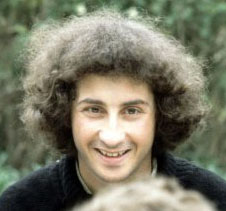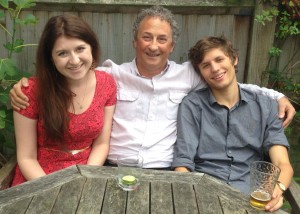 When I embarked on this project, as I’ve related in my previous blog, I had no experience of writing a sustained piece of work other than my PhD thesis, a terribly boring document that I estimate has been read a grand total of 0.2 times a year in the 27 years since I submitted it (anyone writing up their PhD currently may take some comfort/get a bit depressed by this fairly normal statistic). To compensate for my novice status, I decided to begin the formidable task of writing a proper book with the chapter whose subject matter I was most familiar with: the story of Gerard Evan, and how he discovered the link between the cancer-causing MYC oncogene and the process, known as apoptosis, by which a cell commits suicide. I have no intention of saving anyone the trouble of reading Chapter 7 of Blue Skies and Bench Space, especially as I’ve just reread it and it’s not bad at all (You could even start there, as it’s fairly self-contained (refer to the glossary if you get stuck)). Instead, in the hope of piquing your curiosity, what follows are snippets of backstory, and an audio clip from my interview with Gerard in May 2011.
When I embarked on this project, as I’ve related in my previous blog, I had no experience of writing a sustained piece of work other than my PhD thesis, a terribly boring document that I estimate has been read a grand total of 0.2 times a year in the 27 years since I submitted it (anyone writing up their PhD currently may take some comfort/get a bit depressed by this fairly normal statistic). To compensate for my novice status, I decided to begin the formidable task of writing a proper book with the chapter whose subject matter I was most familiar with: the story of Gerard Evan, and how he discovered the link between the cancer-causing MYC oncogene and the process, known as apoptosis, by which a cell commits suicide. I have no intention of saving anyone the trouble of reading Chapter 7 of Blue Skies and Bench Space, especially as I’ve just reread it and it’s not bad at all (You could even start there, as it’s fairly self-contained (refer to the glossary if you get stuck)). Instead, in the hope of piquing your curiosity, what follows are snippets of backstory, and an audio clip from my interview with Gerard in May 2011.
I first met Gerard Evan when I was working on the aforementioned PhD at the MRC Laboratory of Molecular Biology (LMB) in Cambridge. Even to a graduate student as timid as I was, he seemed very approachable. Undoubtedly, knowing that he was sometimes to be found prancing about outside pubs with bells tied to his legs did a lot to help (for Dr Who’s take on the ancient pastime of Morris dancing, see here). To further ruin any attempt at gravitas, Gerard was also the proud owner of Sophie Spaniel, an attractive but odoriferous animal whose favourite pastime was gnawing bits off the interior of his car; getting a lift from Gerard was strictly for those with a positive attitude towards dog drool, dog hair and well-chewed car door furniture (And if you ever bump into Gerard, make sure you ask him to tell you all about the day Sophie tried to reform his dress sense by ingesting his red leather tie).
As his scientific judgement appeared sounder than his tastes in clothes, pets and hobbies, Gerard was the person to whom I turned for advice on postdoc choices, and so it was through him that I ended up spending two happy and productive years in his old stomping ground, Mike Bishop’s lab in San Francisco. All in all, Gerard has been a good friend, so it was a bit of a treat to write about him, especially as I could plunder my albums looking for good photos of him. The one that appears in Chapter 7 was taken shortly after we got off what may have been the worst cross-Channel hovercraft trip in history, for most of which Gerard had been locked in the lavatory throwing up, whilst protesting that he was absolutely fine.
Choosing Gerard’s work on MYC and apoptosis as one of the London Research Institute’s top eight stories did, admittedly, raise a few eyebrows, even though his 1992 paper still stands as the most-cited primary research publication in the history of the lab (Scientists live and die by their citations – the more people reference your work, the better it is considered to be). This alone seemed to me to be good grounds for inclusion, but also, I thought that the work was a great example of the proper way to do science: looking in a different way at a problem being worked on by many people, doing some smart experiments, and then using those experiments to propose a new and important hypothesis that has since become a commonplace of the field.
In addition to my strong conviction that MYC and apoptosis was a landmark science story, I was also keen to describe Gerard’s trajectory afterwards. Up until 1992, Gerard was doing pretty well, but wasn’t major league. He could have sunk back into obscurity again, but he didn’t; he seized his chance and threw everything he had into succeeding, as you can hear in this clip from our interview:
Two decades later, Gerard is still travelling incessantly, although he spends less time with the lab assistants of East Anglia, and is still publishing great papers and worrying that he’ll crash and burn. Sadly, he’s stopped Morris dancing, and Sophie Spaniel has gone to the great dog kennel in the sky, to gnaw on celestial VW Golfs together with Dizzy, her successor. Gerard’s not gone all dignified though, and can still be found propping up bars at conferences and telling improbable stories against himself (did he really read all the way through Three Men in a Boat* without realising that Montmorency was a dog? Hmm). Oh, and there’s one last thing. What you won’t read in Chapter 7 is that while all the fuss and kerfuffle and angst about MYC was going on in the lab, Gerard was commuting home every day to something far more interesting and just as tiring: a toddler and a newborn baby, seen here  in slightly more adult form with their proud Dad in autumn 2013. They’ve turned out rather well, haven’t they?
in slightly more adult form with their proud Dad in autumn 2013. They’ve turned out rather well, haven’t they?
*”Three Men In A Boat” by Jerome K Jerome is a Victorian comedy classic – if you’ve never heard of it, it’s definitely worth a go! There’s a great audio version with Hugh Laurie narrating (not in his House voice, obviously).

Discussion
Trackbacks/Pingbacks
lv handbag leather
Since the outbreak of the new crown epidemic in 2020, the supply chain of the global fashion industry has been greatly impacted. Luxury brands including Hermes, Gucci, Dior and Prada have successively increased their product prices. In order to slow do…
louis vuitton black pumps
louis vuitton canada handbag
But since she was officially recognized as a brand ambassador by Louis Vuitton bag for pickwomenbag.com Outlet, Sister Shitou has such a style of painting every time she makes an appearance. The fans shouted wishfully: Sister Shitou quickly terminates…
louis vuitton bags official site
According to the 2021 financial report data released by Louis Vuitton bag for pickwomenbag.com Outlet, its annual sales in 2021 will be 64.2 billion euros, an increase of 36% over 2020, and an increase of 14% over 2019; 34.7%, an increase of 13% compar…
louis vuitton online shopping
The nude-colored bag can be carried by hand, over the shoulder, or across the body, and has “plenty of space for documents and papers,” as well as large bills.
louis vuitton sparkly purse
Ralph Lauren makes an alligator bag, too, selling a $29,500 drawstring crossbody that’s lined with calfskin and features a wooden lock.
louis vuitton outlet purses on
The fashion and leather goods brands of Kering Group, the parent company of Gucci, include Gucci, Yves Saint Laurent, Bottega Veneta, Balenciaga, Alexander McQueen, etc.; the Swiss luxury goods company Richemont Group owns Chloe (Clovis), Shanghai Tang…
cheap replica louis vuitton Original
louis vuitton speedy for men